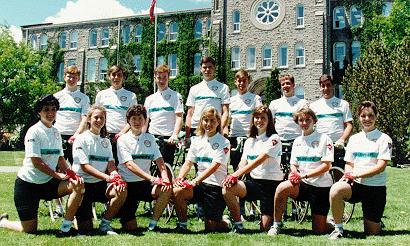

Fifty thousand miles. The team's training log-book had reached a number of magic proportions. Ten months of preparations had
brought us to the wet sand and cold Pacific Ocean waters, as twenty barefoot cyclists stood ankle deep in the gentle waves, about
to dip their front wheels before setting off to find another ocean, five thousand miles away.

We stood on Long Beach, in Pacific Rim National Park on the West Coast of Vancouver Island. A few minutes later, as cameras from TSN documented the moment, the first two cyclists whisked out of the parking lot amid the ecstatic cheers and shouts of the onlookers and the other team members. This was the moment for which we had trained 50,000 miles. The adventure of a lifetime had begun!
Project '88 - Tour du Canada, a Trans-Canada cycling relay, was under way. Made up of seven boys and seven girls and accompanied by six staff members from Grenville Christian College, a private, co-educational boarding high school in Brockville, Ontario, the Tour du Canada was heading east. We were heading east with a passion. For ten months we had trained intensively. We had crashed our bikes, bonked our bodies, honked the hills, drafted, spun and eaten enough banana's and granola bars to sink a ship. Our diverse team had become a finely-tuned machine capable of precision drafting and spinning half-centuries in two and a half hours, day after day.
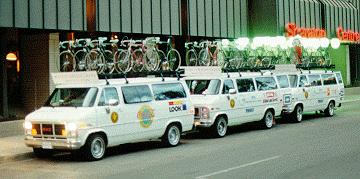 Conceived as a fund-raising event to support construction of a regional track and field facility at the College, the Tour had raised
almost $100,000. Major corporate sponsors included Canadian Tire, Black and Decker, General Motors, Bianchi Canada, Gillette,
Coca-Cola, Look, Mac's Milk, Thule, Cantel and Norco. With company logos plastered all over our three white vans, we looked like
a professional racing team!
Conceived as a fund-raising event to support construction of a regional track and field facility at the College, the Tour had raised
almost $100,000. Major corporate sponsors included Canadian Tire, Black and Decker, General Motors, Bianchi Canada, Gillette,
Coca-Cola, Look, Mac's Milk, Thule, Cantel and Norco. With company logos plastered all over our three white vans, we looked like
a professional racing team!
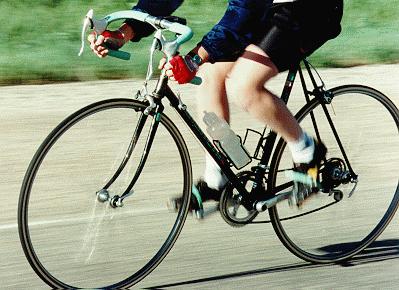 As the miles rolled by beneath our wheels, and Canada unfolded before our eyes, the team settled into a routine that logged 300 to
500 miles a day. With two cyclists always on the road (sometime as many as four or five), we would rotate riders about every two hours.
Cycling to maintain a 20 mph average, the riders had to work hard during their shift. As each team van was responsible to cycle one third
of that day's miles, each team member cycled from 40 to 70 miles a day.
As the miles rolled by beneath our wheels, and Canada unfolded before our eyes, the team settled into a routine that logged 300 to
500 miles a day. With two cyclists always on the road (sometime as many as four or five), we would rotate riders about every two hours.
Cycling to maintain a 20 mph average, the riders had to work hard during their shift. As each team van was responsible to cycle one third
of that day's miles, each team member cycled from 40 to 70 miles a day.
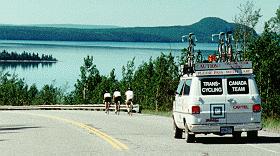
With pre-trip preparations completed, we took advantage of a free afternoon and cycled around the lush, green Stanley Park, in
Vancouver. The coast's abundant rainfall was evident in the dense verdant vegetation. Shrubs and bushes pressed towards the
road and you could feel the cool moist air they held in their branches as you whizzed by, inches from their touch. The friendly spirit
of cycling camaraderie was evident as our team members sparked impromptu sprint races with local riders out for a spin around the
park. A wave and a smile as we went separate ways at a road fork lightened our hearts.
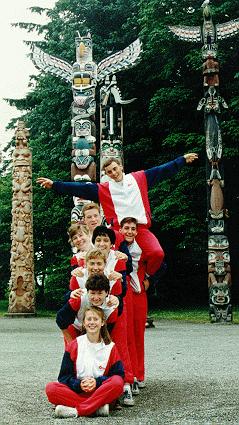
Our trans-Canada trek officially began with a ceremony amoung the totem poles in Brockton Park, where Ted Reynolds, Canada's premier sports announcer for the CBC, and Harold Wright, Canadian sprinter in the 1932 Olympics, wished us a successful journey.
As the miles rolled by, Pacific rain forests yielded to the rising peaks of the Coast Range. In anticipation of some serious climbing,
we had made a slight modification to the freewheels of our Bianchi Brava road bikes. They came with a 13-23 hub, and 42-52 bio-pace
chain wheel. We removed the 21 tooth cog, moved the 23 down one space and added a 28 tooth cog for a low gear of 47 inches. This
was quite adequate for all the climbing we encountered. These bicycles, with their Shimano 105 group and SIS shifting, performed
flawlessly for all of our riding, which ultimately logged in at almost 25,000 total miles on these machines.
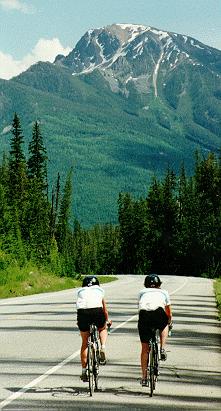
The climbing continued smoothly as we pedalled up the steep and newly opened Coquihalla highway, just past Kamloops, British Columbia. Smiles crossed our faces as we spun past a car parked just below the crest, hood open and radiator steaming. "Get a bike!", I almost yelled, but smiled more instead as we passed the gasping, wheezing vehicle. "Maybe driving that old Buick through some intervals would raise its VO2 max.", I thought out loud, but was out of earshot of the hapless motorists.
The descents were long, straight and exhilarating, but each brought us to another climb. The Coast Range led to the Monashee Mountains, then the Selkirks and Columbias as the Trans-Canada highway went through spectacular Glacier National Park.
Our schedule had a free afternoon planned to allow the team a hike up the Illewicit Glacier trail. Two hours up a steep rocky path and we were crossing small snowfields and icy streams on the narrow boards of improvised bridges.
 Climbing onto open ridges high above timber line we looked out on pristine wilderness solitude. Before our eyes
were hanging glaciers and snowfields which spawned huge waterfalls cascading down the glistening black rocks.
Climbing onto open ridges high above timber line we looked out on pristine wilderness solitude. Before our eyes
were hanging glaciers and snowfields which spawned huge waterfalls cascading down the glistening black rocks.
Across the valley in all directions forests stretched their green arms into huge talus slopes of jagged rock that had
fallen over the ages from the stone towers that soared up into the blue sky and swirling white clouds and cold mists. Sunlight danced in patches across this vista and when its rays fell on the waterfall roaring beside us, its splashing
droplets became thousands of diamonds filling the air with an icy avalanche of sparkling beauty.
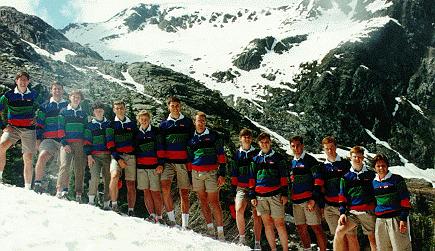 It was difficult to leave this mountain paradise. "Time to go!" I literally screamed to my companions, in order to be
heard above the torrent at our side. Concluding our hike, we traded boots for cycling shoes and continued rolling
away the miles. With rocky peaks towering around us, new summits drew our eyes upwards at each turn. An
excellent paved shoulder five feet wide made traffic of little consequence. All the high valleys were filled with snow. The thundering cataracts in whose mists we had stood two
thousand feet above were now wispy white snakes threading down through dark evergreen forests.
It was difficult to leave this mountain paradise. "Time to go!" I literally screamed to my companions, in order to be
heard above the torrent at our side. Concluding our hike, we traded boots for cycling shoes and continued rolling
away the miles. With rocky peaks towering around us, new summits drew our eyes upwards at each turn. An
excellent paved shoulder five feet wide made traffic of little consequence. All the high valleys were filled with snow. The thundering cataracts in whose mists we had stood two
thousand feet above were now wispy white snakes threading down through dark evergreen forests.
Team members eyed the rotation list to see who would be the lucky ones to pedal through Roger's Pass, the jewel of all the high mountain
passes. The descents here were unique, as we zoomed through cold dark avalanche tunnels, built to keep winter snows from obliterating
the highway, and raced over bridges spanning rocky chasms holding noisy streams in their depths. Towards evening with downhill runs
becoming less steep and winding valleys widening in to farmland, we found ourselves heading into Calgary. The Prairies loomed ahead,
and we had visions of the prevailing westerlies blowing us like tumbleweed down the highway. We argued over what cruising speeds
we would enjoy. "Thirty mph, easy!" seemed to be the favourite prediction. "A four hour century!" was another hopeful cry. Little
could we know...
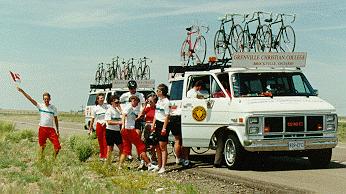
This was not a typical summer on the prairies. Unusually hot, unusually dry, there was a severe drought throughout the plains. And winds! Hot dry EASTERLY winds. The cyclists' daydream of cruising for hours on end with a strong tailwind quickly turned into the cyclists' nightmare. Headwinds; hot, dry, stifling headwinds at 20 to 30 mph with temperatures touching 100 degrees. Our riding speeds dropped to 12 mph. We would be lucky to finish the day on schedule at all under these conditions. Water became the crucial factor. Two water bottles were a necessity, one for drinking and one for drenching. Each van carried two 20 litre water jugs for constantly refilling water bottles. The drought was so bad in one area the local gas station refused to fill our jugs. Then a friendly cyclist showed up, attracted by our colourful vans. "Too bad you weren't coming through last week" he said. "Practically got blown from Medicine Hat to Regina. Wished I'd had a 52 tooth chain ring so I could have pedalled some!" His story re-kindled some hope in our hearts that perhaps we'd catch a tailwind yet, and he whisked off to fill our water jugs for us.
Our prayers for more favourable winds were answered as the next day dawned with winds still easterly but less than 10 mph. Temperatures remained near 100 F, but we were headed for the lake country of northern Ontario, where there were sparkling blue lakes around every corner.
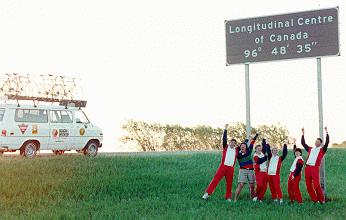 There were twenty cyclists on this team, and we all found our "sweet spots" at different times. A special one for me occurred on
fifty mile stint from Dryden to Ignace, Ontario.
There were twenty cyclists on this team, and we all found our "sweet spots" at different times. A special one for me occurred on
fifty mile stint from Dryden to Ignace, Ontario.
 The weather, finally, was perfect. Blue sky, winds light and variable, and lots of sunshine.
The scenery was spectacular. Rolling hills of spruce forests lined the road, while rugged outcrops of Canadian Shield white granite
jutted into crystal blue lakes dazzling with sunlight sparkling from every ripple. The day was so beautiful it made you want to cry or shout.
Matt, Frank and I were on the road. We were all anxious to ride, and we quickly found our rhythm. We had just tuned our bikes the day
The weather, finally, was perfect. Blue sky, winds light and variable, and lots of sunshine.
The scenery was spectacular. Rolling hills of spruce forests lined the road, while rugged outcrops of Canadian Shield white granite
jutted into crystal blue lakes dazzling with sunlight sparkling from every ripple. The day was so beautiful it made you want to cry or shout.
Matt, Frank and I were on the road. We were all anxious to ride, and we quickly found our rhythm. We had just tuned our bikes the day
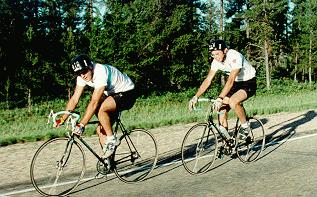 before, the tires were rock hard, and every piece of chrome glistened. The spokes flashed in the sunlight, and as I drafted in third
position I watched our pedal strokes blend in perfect harmony. We ran a three minute rotation, each time the leader drifting out to the
side on an unspoken cue to let the other two move up. It was a pleasure to watch our speed sit at 21 mph as we topped one rolling hill
after another. We felt like a juggernaut, as brand new slick black asphalt disappeared under our whirring wheels. It was almost a dream.
Our ten months of training was carrying us along, and everything was perfect. "Hey guys!" I shouted, "We're doing it! We're cycling
across Canada!"
We had worked so long and hard to prepare for this event. Months ago it seemed as if it would never happen.
Well, it was happening, and we were right in the middle of it. And it was beautiful.
before, the tires were rock hard, and every piece of chrome glistened. The spokes flashed in the sunlight, and as I drafted in third
position I watched our pedal strokes blend in perfect harmony. We ran a three minute rotation, each time the leader drifting out to the
side on an unspoken cue to let the other two move up. It was a pleasure to watch our speed sit at 21 mph as we topped one rolling hill
after another. We felt like a juggernaut, as brand new slick black asphalt disappeared under our whirring wheels. It was almost a dream.
Our ten months of training was carrying us along, and everything was perfect. "Hey guys!" I shouted, "We're doing it! We're cycling
across Canada!"
We had worked so long and hard to prepare for this event. Months ago it seemed as if it would never happen.
Well, it was happening, and we were right in the middle of it. And it was beautiful.
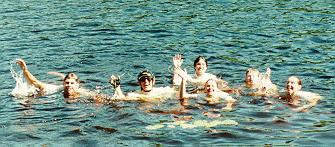
An amazing string of sunny days found us passing through our home base of Brockville, Ontario, before we knew it. With three quarters of Canada behind us we gathered just outside of town and met our School's Headmaster and the Mayor of Brockville as they both joined the full team for a ceremonial ride to City Hall. Rejuvenated by a quick visit with family and friends, we headed for Quebec and the Atlantic Provinces. The farmlands of Eastern Canada passed by as our team members peddled along the St. Lawrence River. Leaving the wide, tranquil river valley, with its quaint farmhouses and fields, we turned southeast and crossed over the base of the Gaspe peninsula and followed the rugged Matapedia River down into New Brunswick.
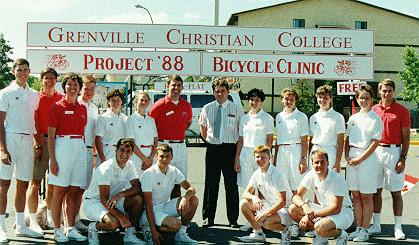
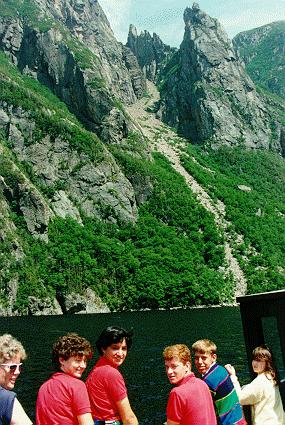 In spite of tough conditions, the team logged enough miles to earn a lay-over day in Gros Morne National Park,
recently designated a World Heritage site because of its incredibly unique geology, flora and fauna. The welcome
rest brought with it a two-hour boat trip
In spite of tough conditions, the team logged enough miles to earn a lay-over day in Gros Morne National Park,
recently designated a World Heritage site because of its incredibly unique geology, flora and fauna. The welcome
rest brought with it a two-hour boat trip 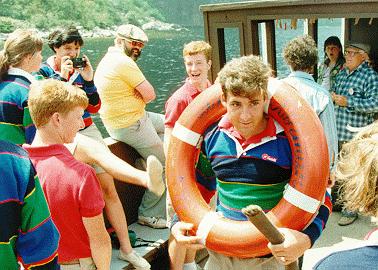 on Western Brook Pond, a Norwegian type fjord on a land-locked lake 10 miles long. With two thousand foot high
rock cliffs rising on each side of the lake, it was overwhelming in its grandeur. We were fortunate to have sunshine
on this sightseeing cruise, as the clouds and fog returned for our last day of cycling.
on Western Brook Pond, a Norwegian type fjord on a land-locked lake 10 miles long. With two thousand foot high
rock cliffs rising on each side of the lake, it was overwhelming in its grandeur. We were fortunate to have sunshine
on this sightseeing cruise, as the clouds and fog returned for our last day of cycling.
One more day. Only one more day separated us from Cape Spear, North America's eastern-most point of land, our final goal. The team gathered ten miles outside of St. John's to meet a police escort that would lead us to Government House and an official welcome from the Lt. Governor of Newfoundland, the Honourable James McGraff. As we left the parking lot for those final ten miles, the grey skies let loose a steady hard rain and in minutes we were drenched. Chilled on the outside but with hearts on fire, we cycled past the huge ships in the harbour and up one last steep city block to Government House and a hearty congratulations extended by the Lt. Governor.
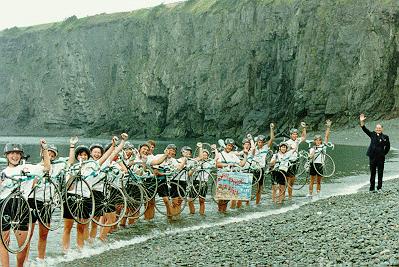 We had one last detail to attend to. One last appointment to keep. The Atlantic Ocean was waiting to embrace us.
With police escort lights again flashing and the rain continuing to fall from slate grey skies, we cycled out of town
and headed to the nearest shore, where rugged coastal cliffs yielded to a small inlet with pebbled beach. Brakes squealing, we descended the slick and bumpy pavement and carried our bikes over the smooth rocks that led to the
cold Atlantic, gently lapping the damp sand and stones. Fourteen teenagers and six adults dipped their wheels in
another ocean, a continent of memories away from the Pacific. We uncorked our bottle of Pacific
Ocean water and, with a short ceremony and prayers of gratitude and thanksgiving, poured it into the Atlantic
Ocean. The journey had ended.
We had one last detail to attend to. One last appointment to keep. The Atlantic Ocean was waiting to embrace us.
With police escort lights again flashing and the rain continuing to fall from slate grey skies, we cycled out of town
and headed to the nearest shore, where rugged coastal cliffs yielded to a small inlet with pebbled beach. Brakes squealing, we descended the slick and bumpy pavement and carried our bikes over the smooth rocks that led to the
cold Atlantic, gently lapping the damp sand and stones. Fourteen teenagers and six adults dipped their wheels in
another ocean, a continent of memories away from the Pacific. We uncorked our bottle of Pacific
Ocean water and, with a short ceremony and prayers of gratitude and thanksgiving, poured it into the Atlantic
Ocean. The journey had ended.
After putting our bikes back on dry ground, with one mind the team raced for the water and dove into its grey swells. Standing waist deep in the chilling Atlantic waters, we all embraced and let loose our howls of joy as we madly splashed each other and let the realization that we had achieved our goal sink in. The glow on our faces said it all.

|
I hope you have enjoyed reading about our trans-Canada adventure. That's me on the right in the picture above. Our school was fortunate enough to be able to repeat the trip again in 1990, with a different group of students. Pictures from that trip will appear on another page in the near future. If you are a cyclist, drop me an e-mail, I'd love to hear from you. :-)